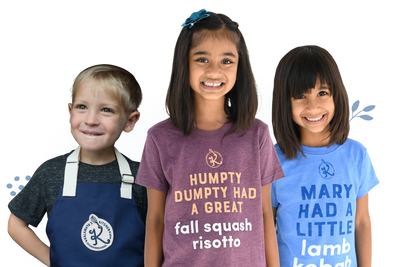
Resources
Of Course It's Kid Friendly!
Kids around the world are proving every day that kid-friendly foods are as vast and flavorful as the world itself.
“My kid won’t touch that. That is not kid-friendly.”
Statements like these are why we created Of Course It’s Kid Friendly. We believe that kids are more open-minded than grown-ups give them credit for, and that often it is a grown-up’s aversion or mistrust of something that prevents a kid from forming their own opinion. Furthermore, many of the foods that we’ve heard parents claim are not kid friendly are eaten by children all over the world, which makes the food, by definition, kid friendly.
I remember feeling bewildered the first time someone suggested to me that dal—and more broadly—all Indian food, was not really “kid friendly”. How could it not be kid-friendly if I, who had once been a kid, had eaten it regularly while growing up? Or while it was the first solid food of billions of kids from the subcontinent, and all around the world? The answer was very obviously in front of me. Of course it’s kid friendly. The real question at hand was “how could anyone think otherwise?”
Perhaps we should back up. What does “kid friendly” even mean? Literally, a food that is kid friendly is one that kids enjoy. Easy enough! Except of course, it isn’t. Does it mean something familiar? Not all kids grow up eating the same food. Does it mean something that kids automatically gravitate towards? Does it mean lots of fat and flavor, like the majority of junk foods and standard kid-menu items, or perhaps very mild flavor, like buttered pasta? And what was the sample size for the kids in this group from which the arbitration around “kid-friendly” food was born? I’m joking with the last question. There is a truly dizzying number of authorities when it comes to the food space and what kids will and won’t eat. I don’t envy parents the task of trying to figure out which one to listen to. I am certainly not here to add to that chorus and tell you what specific food is or isn’t inherently kid friendly. I’m just questioning why one might think that entire cuisines, ingredients, textures, and flavors aren’t.
Let’s go back to the example of dal, and Indian food. The person’s reticence to believe that it could be kid friendly was because this person believed Indian food—all Indian food—to be very spicy, and that kids do not like spice. I am sure that most people are not thinking of it in these terms, but one huge part of this problem is food racism. This is the most hurtful part—that people forget that just because they believe that their kids don’t like a food, that “kids” don’t eat that food. This is a form of cultural supremacy, and one that is important to shine a light on because it is a form that often lurks in the subconscious versus out in open conversation. A lack of familiarity with a food should not translate to the immediate assumption that it is not kid friendly—the fear of the unfamiliar that is passed on through food is an example of how cultural biases become actionable and exclusionary in our society.
I would love it if when faced with a knee-jerk reaction of questioning whether Indian food, for example, is “too” whatever for kids, people could instead take a moment to consider whether that food might be eaten by kids outside of your immediate community. And if yes, to see trying it together as an incredible opportunity for the entire family! If the fear of the unfamiliar is holding anyone, kid or grown-up, from moving forward—trying a new food is a really low-stakes way to realize that different isn’t always scary, and in fact different can be delicious.
Grown-ups are also often quick to dismiss a food as not kid friendly because they themselves just don’t care for it. And, in fairness, kids are very vocal about flavors and textures they don’t care for. But there’s a really big difference in whether or not they’ve had the opportunity to form those opinions themselves, or whether someone has formed it for them. The reality is that people are often too quick to dismiss or mistrust foods (and people) who are not like themselves, and it’s all too easy to pass these quick judgements and biases on to kids. In terms of cultural biases, we all should hold ourselves to a standard of dismantling the barriers that allow them to persist. As for passing on biases due to dislikes, we’re all certainly allowed to not like something—but in proactively using one’s own dislike as a reason for a child not to try something, we risk potentially keeping a kid from an experience that they might really love, and more importantly, denying them an important opportunity to value the forming of their own opinions.
Again, I’m certainly not trying to dictate what you should or shouldn’t feed your kids—there are nightly struggles with time, budget, preference, and a million other factors that can go into any given meal or snack, and not every food experience is going to be a positive one. But I am asking everyone to reconsider the way they look at the unfamiliar, and perhaps ask if deeming something not worth the effort of introducing to a child comes from lived experience and their actual tastes, or something else. If it’s something else—food offers us an incredible opportunity to examine the way we think about the world, and each other. Let’s afford that opportunity to kids too, as early and as enthusiastically as we can.

